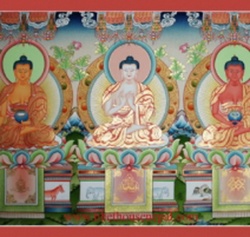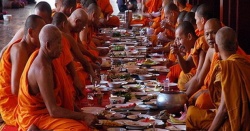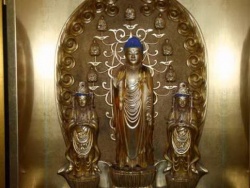Chinese Cultural Studies:Doctrinal classification by Peter N. Gregory
Doctrinal classification (p'an-chiao) has often been said to be the hallmark of Chinese Buddhism. Although this judgment is surely one-sided-ignoring as it does many rich areas of more "popular" developments-it is certainly no exaggeration when applied to Chinese Buddhist scholastic writing such as that found in the great T'ien-t'ai compendia of teachings. Doctrinal classification is one of the most striking features of Chinese Buddhist scholasticism, and we cannot understand how medieval Chinese Buddhist scholars such as Chih-i (538-597) thought without understanding p'an-chiao.
The doctrine of expedient means provided the main hermeneutical device by which Chinese Buddhists systematically ordered the Buddha's teachings in their classificatory schemes. It enabled them to arrange the teachings in such a way that each teaching served as an expedient measure to overcome the particular shortcoming of the teaching that preceded it while, at the same time, pointing to the teaching that was to supersede it. In this fashion a hierarchical progression of teachings could be constructed, starting with the most elementary and leading to the most profound.
While the enterprise of doctrinal classification never had the importance in Indian Buddhism that it was to assume in China, the methodology used in Chinese p'an-chiao was, nevertheless, clearly anticipated in a few Indian Buddhist scriptures. One of the most important examples was the Sam\d\ba6()\s\do2(.)\d\fo1()dhinirmocana-su\d\ba4()\s\up4()tra's teaching of the three turnings of the dharma wheel. According to this early Yoga\d\ba5()\s\up4()\d\fo1()ca\d\ba5()\s\up4()\d\fo1()ra text, the Buddha's teachings could be divided into three successive periods, the order of which represented an ever more profound revelation of the truth. The first of these was contained in the teaching of the lesser vehicle, which taught that there was no substantial self. Yet, because it failed to teach the emptiness of all things (dharmas), it was not ultimate. It was therefore superseded by a second teaching, that contained in the Perfection of Wisdom scriptures, which taught the emptiness of all things. This teaching, however, was also not ultimate, and a third and final teaching, which elucidated (nirmocana) the hidden meaning (sam\d\ba6()\s\do2(.)\d\fo1()dhi) of the Perfection of Wisdom, accordingly had to be taught. This was, of course, the teaching of the Sam\d\ba6()\s\do2(.)\d\fo1()dhinirmocana itself.
The Sam\d\ba6()\s\do2(.)\d\fo1()dhinirmocana applies the notion of expedient means within a chronological framework in order to account for the succession of teachings according to different stages in the Buddha's teaching career. Another important Indian Buddhist example, which was to play a significant role in the doctrinal classification system used in the T'ien-t'ai tradition, was the parable of the five flavors found in the Nirva\d\ba4()\s\up4()n\d\ba5()\s\do2(.)\d\fo1()a Su\d\ba4()\s\up4()tra. This second example could also be interpreted in chronological terms, as it was under the later T'ien-t'ai rubric of the "five periods." However, it had a less restricted application as it was originally used by Chih-i (538-597). It suggested that the dharma could be understood in terms of successive stages of refinement analogous to the stages by which ghee (liberation) is derived from milk. Just as milk derives from a cow, cream derives from milk, butter derives from cream, melted butter derives from butter, and ghee derives from melted butter, so "the twelve divisions of the canon derive from the Buddha, the su\d\ba5()\s\up4()\d\fo1()tras derive from the twelve divisions of the canon, the extended (vaipulya, i.e., Maha\d\ba5()\s\up4()\d\fo1()ya\d\ba5()\s\up4()\d\fo1()na] su\d\ba5()\s\up4()\d\fo1()tras derive from the su\d\ba5()\s\up4()\d\fo1()tras, the Perfection of Wisdom derives from the extended su\d\ba5()\s\up4()\d\fo1()tras, and nirva\d\ba5()\s\up4()\d\fo1()n\d\ba5()\s\do2(.)\d\fo1()a, which is like ghee, derives from the Perfection of Wisdom."
Even though the examples from these two Indian Buddhist scriptures served as prototypes for Chinese Buddhist p'an-chiao schemes, doctrinal classification itself never played the crucial role in Indian Buddhism that it did in China. Although Indian Buddhism splintered into many sects, each sect was still part of an unbroken religious evolution. Nor were Indian Buddhists called on to justify their existence as a social group whose presence threatened the values and socio-political structures of Indian society. Even though the different sects disputed with one another, they could all claim some form of linkage to the historical Buddha. And this consciousness of historical linkage made it unnecessary for them to account for the teachings of other sects in a systematic fashion.
In China, however, the situation was entirely different. First of all, Buddhism was very much an alien tradition that violated some of the most cherished values of Chinese civilization. From the time that Buddhism first began to make its presence felt within Chinese society, it was subjected to an unrelenting stream of objections from its Confucian-minded critics. Many of the aspects of the new religion that the Chinese found most objectionable were more a reflection of the general Indian world-view of which Buddhism was a part than particular teachings and practices specific to Buddhism among the religious traditions of India. Many of the most pressing issues with which Chinese Buddhist apologists had to deal thus never arose in the Indian cultural context.
Celibacy, for example, was already an established custom among Indian ascetics when the Buddha enjoined its practice on his monks and nuns. In China, however, not only did celibacy play no role in its indigenous religious practices, it also transgressed the familialism at the heart of Chinese cultural values. The continuation of the family line was a duty made sacred by the need to ensure the proper maintenance of ancestor worship. The emphasis placed on producing progeny was duly stated by Mencius: "There are three things which are unfilial, and to have no posterity is the greatest of them." A celibate son, renouncing his sacred duty for a life as a Buddhist monk, thus seemed to threaten the very cohesiveness of Chinese society.
Celibacy became institutionalized in the cenobitic lifestyle followed by Buddhist monks in India, where the monastic institution existed as an autonomous social body outside of secular authority. In China, however, the extraterritorial claims of the monastic institution not only infringed on the prerogatives of the state but also challenged the sacred character of the emperor in both his moral and sacerdotal capacity, invested on him by heaven, of maintaining the proper harmony between the socio-political realm and the way of heaven. The existence of a class of nonproductive monks, moreover, offended the Chinese work ethic. It was also decried on purely pragmatic grounds by generations of government officials who saw in it a loss of vital sources of tax revenue and manpower. In India, on the other hand, far from being seen as an economic drain on society, nonproductive religious seekers of all denominations were revered by pious laymen as an all-important means for gaining religious merit by providing a field in which they could sow the seeds of good karma and so improve their spiritual prospects in a life to come.
Chinese critics were never at a loss for articulating other, and in their context equally persuasive, objections to Buddhism. Most of these, however, focused on the impact that Buddhism had as a corporate institution on Chinese society. Aside from the traditional array of social, political, economic, and moral objections levelled against Buddhism, the very values to which Buddhists often appealed in justifying their existence as a distinct and privileged group within Chinese society went against the this-worldly orientation of Chinese civilization, in which there was little distinction between sacred and profane. In India, however, the renunciation of worldly life by religious seekers intent on breaking the shackles of existence was a hallowed, if socially ambivalent, ideal. Rather than viewing the religious life as a separate and higher norm, the Chinese have tended, instead, to invest the secular with religious meaning.
While the objections that Chinese Buddhists had to address in justifying their existence as a distinct group within Chinese society were not, strictly speaking, part of the hermeneutical problem of correctly interpreting the Buddha's teachings, they nevertheless formed the background against which Chinese Buddhists addressed the problem. It was, after all, necessary for Buddhism to reach some form of accommodation with Chinese values and socio-political structures in order for it to take root and grow in Chinese cultural soil. Buddhism had to divest itself of its Indian trappings and become Chinese. Thus, whether or not they attempted to answer their Confucian-minded critics, Chinese Buddhists, by the very fact of being Chinese, approached Buddhism with a problem consciousness (in most cases all the more powerful because unconscious) very different from their Indian counterparts.
In addition to the unique perspective from which Chinese Buddhists approached the task of interpreting the Buddha's teachings, the hermeneutical problem was for them a more urgent one than it was for their Indian brethren, for whom all the different manifestations of Buddhism were an organic part of the evolving Indian cultural matrix out of which Buddhism originally developed. To Chinese Buddhists, however, not only did Buddhism itself demand justification, but the further problem of interpreting the confusing array of teachings they inherited as the sacred word of the Buddha also proved to be equally vexatious. Chinese Buddhists were, as their Indian counterparts were not, called on to make sense out of Buddhism as a totality.
The problem was exacerbated by the fact that the Chinese never received Buddhism as a complete and coherently wrought system. Rather, the transmission of Buddhism to China took place over a period of centuries-centuries in which Indian Buddhism itself continued to develop and change in profound ways. The process of transmission occurred in a fragmented and haphazard fashion. The order in which texts were translated into Chinese bore no relation to the chronology of their composition. Later texts were often made available before the earlier texts on which they were based or to which they were a response. This situation meant that teachings were introduced divorced from both their historical and doctrinal context, thus making it even more difficult for the Chinese to arrive at an accurate understanding of them. Moreover, the Indian and [[Wikipedia:Central Asian|Central Asian]] missionaries, who served as the vital link in this process of transmission, hailed from different Buddhist traditions and were often at odds in their interpretation of the various teachings that the Chinese were groping to comprehend.
The historical process by which Buddhism was transmitted to China generated its own set of problems that framed the context in which the Chinese had to operate in their attempt to gain an understanding of the tradition as a whole. Although this situation certainly made the task more difficult, it also opened up the field for speculation, in which Chinese Buddhists could exercise their own genius in defining their own unique form of Buddhism that was at once thoroughly Chinese and authentically Buddhist.
Indeed, the history of Chinese Buddhism can be represented in terms of the development of the increasingly sophisticated hermeneutical frameworks that were devised to understand a religion that was in its origin as foreign conceptually as it was distant geographically. This hermeneutical process, by which Chinese Buddhists gradually came to assimilate Buddhism into their own cultural modalities, could also be characterized in terms of successive phases of "sinification."
The first phase, covering the third and fourth centuries, is masterfully documented in Erik Zrcher's classic study, The Buddhist Conquest of China. It represents the period in which Chinese Buddhists tried to understand their newly imported religion in terms of their own cultural and inellectual frames of reference, especially "Neo-Taoism" (hsan-hseh). It is only at the end of the fourth century, with figures like Tao-an (312-385) and Hui-yan (344-416), that Chinese Buddhists begin to become aware of the distorting lens through which they had come to understand their tradition. At the same time, it was only toward the end of the fourth century that enough texts had been translated for Chinese Buddhists to become aware of the diversity of teachings to which they were heir.
The fifth century, with the arrival of Kuma\d\ba5()\s\up4()\d\fo1()raji\d\ba4()\s\up5()va in Ch'ang-an in 401, begins the second phase of the Chinese attempt to understand Buddhism. Chinese Buddhists, aware of the limitations of earlier efforts to understand the tradition, turned to foreign authorities and sources in order to understand Buddhism on its own terms, shorn of the cultural filters that had characterized the previous period. This period, which extends on through most of the sixth century, is marked by an increasingly scholastic turn. It is the period of the exegetical "schools," which attempt to master the various scholastic traditions of Indian Buddhism. In addition to the Kuma\d\ba5()\s\up4()\d\fo1()raji\d\ba4()\s\up5()va's authoritative translations of a number of critically important Maha\d\ba5()\s\up4()\d\fo1()ya\d\ba5()\s\up4()\d\fo1()na texts (especially those associated with the Perfection of Wisdom), this period witnessed the rendering into Chinese of a number of major Yoga\d\ba5()\s\up4()\d\fo1()ca\d\ba5()\s\up4()\d\fo1()ra scriptures and treatises, which became the central focus of Chinese scholastic thought. The gradual assimilation of Yoga\d\ba5()\s\up4()\d\fo1()ca\d\ba5()\s\up4()\d\fo1()ra thought over the sixth century laid the doctrinal ground on which was constructed the new Buddhism of the Sui and T'ang period, which of course represents the third phase in this threefold typology of the process of sinification.
It was during this second period that the Chinese first began to grapple with the hermeneutical problem of rendering intelligible the variegated expanse of Buddhist teachings, and accordingly it was during the early part of the fifth century that the first doctrinal classification schemes were articulated. One of the earliest p'an-chiao systems was devised by Hui-kuan, a figure associated with the exegetical tradition centering on the Nirva\d\ba4()\s\up4()n\d\ba5()\s\do2(.)\d\fo1()a Su\d\ba4()\s\up4()tra and best-known for his opposition to Tao-sheng's theory of sudden enlightenment. In his preface to the Nirva\d\ba4()\s\up4()n\d\ba5()\s\do2(.)\d\fo1()a Su\d\ba4()\s\up4()tra, Hui-kuan divided the Buddha's teachings into two general types: the sudden (tun) and gradual (chien). The sudden teaching corresponded to the Avatam\d\ba6()\s\do2(.)\d\fo2()saka (Hua-yen) Su\d\ba4()\s\up4()tra, which fully revealed the truth and was taught for only the most advanced bodhisattvas. Hui-kuan then divided the gradual teachings into five periods. The first period was one in which the three vehicles were taught separately (san-sheng pieh-chiao): that is, the Buddha taught the four noble truths to s\d\ba5()\s\up0()\d\fo1()ra\d\ba5()\s\up4()\d\fo1()vakas, the twelvefold chain of conditioned origination to pratyakabuddhas, and the six perfections to bodhisattvas. Because the cause of practice for the followers of each vehicle was not the same, the result that they attained was different. The second period was characterized by the teaching that runs through the three vehicles (san-sheng t'ung-chiao) and corresponds to the Perfection of Wisdom. The third period, in which the Buddha denegrated the s\d\ba5()\s\up0()\d\fo1()ra\d\ba5()\s\up4()\d\fo1()vakas and praised the bodhisattvas (i-yang-chiao)-the teaching, that is, in which he made clear the inferiority of Hi\d\ba4()\s\up5()naya\d\ba5()\s\up4()\d\fo1()na and proclaimed the superiority of Maha\d\ba5()\s\up4()\d\fo1()ya\d\ba5()\s\up4()\d\fo1()na-is represented by the Vis\d\ba5()\s\up0()\d\fo1()es\d\ba4()\s\do2(.)\d\fo1()acinta\d\ba4()\s\up4()brahmaparipr\d\ba3()\s\do2(.)ccha and Vimalaki\d\ba3()\s\up5()rti su\d\ba5()\s\up4()\d\fo1()tras. The fourth period corresponds to the universal teaching (t'ung-kuei-chiao) of the Lotus Su\d\ba4()\s\up4()tra, according to which the three vehicles were all subsumed into the one vehicle. The fifth and final period corresponds to the Nirva\d\ba4()\s\up4()n\d\ba5()\s\do2(.)\d\fo1()a Su\d\ba4()\s\up4()tra's teaching of the eternality of the Buddha (ch'ang-chu-chiao).
Hui-kuan's p'an-chiao is surprisingly sophisticated and anticipates the taxonomical differentiations in the ways of classifiying the teachings only made explicit in the eighth-century formulation of the five periods and eight teachings of Chan-jan (711-782). As this later T'ien-t'ai scholar makes clear, Buddhist teachings could be classified according to three different rubrics: (1) method of exposition, (2) content, and (3) chronology. These different classificatory rubrics were necessitated, at least in part, by some of the problems posed by the Avatam\d\ba6()\s\do2(.)\d\fo2()saka Su\d\ba4()\s\up4()tra. This scripture was generally acknowledged as containing one of the most profound, if not the most profound, revelations of Maha\d\ba5()\s\up4()\d\fo1()ya\d\ba5()\s\up4()\d\fo1()na. At the same time, it was also generally regarded by Chinese Buddhists as being the first preaching of the Buddha. A simple chronological arrangement, such as the Sam\d\ba6()\s\do2(.)\d\fo1()dhinirmocana's three turnings of the dharma wheel, which assumed that the order in which the Buddha preached his different teachings represented a progression beginning with the most elementary and advancing to the most profound, therefore could not account for the Avatam\d\ba6()\s\do2(.)\d\fo2()saka Su\d\ba4()\s\up4()tra. A chronological arrangement of the teachings did not match their arrangement according to their content. Thus, whereas the Avatam\d\ba6()\s\do2(.)\d\fo2()saka Su\d\ba4()\s\up4()tra would have to be placed first in a chronological arrangement, it could be ranked last-i.e., highest-in terms of an arrangement according to content. The sudden-gradual distinction circumvented this problem by suggesting that the Avatam\d\ba6()\s\do2(.)\d\fo2()saka Su\d\ba4()\s\up4()tra differed from the other teachings of the Buddha not so much in terms of its ultimate content as in the way that content was revealed. The distinction between sudden and gradual teachings thus had to do with their method of exposition. The sudden teaching differed from the gradual in that it directly proclaimed the ultimate truth without recourse to expedients. The truth that it revealed was the same as that to which the gradual teachings led by a graduated progress. Its content, therefore, did not differ from that of the highest of the gradual teachings.
In the fifth and sixth centuries Chinese Buddhists like Hui-kuan employed p'an-chiao as a hermeneutical strategy to reconcile the discrepancies among the different teachings believed to have been taught by the Buddha. By resorting to the doctrine of expedient means, they were able to create a hierarchical framework within which the entire range of Buddhist teachings could be systematically organized into a coherent doctrinal whole. But p'an-chiao was not a neutral methodology. Nor did the rubric of expedient means offer any basis on which to decide the order in which the various teachings were to be classified. The order in which the teachings were ranked was a matter of interpretation that called for value judgments in regard to which scripture or scriptural corpus was to be taken as authoritative. Thus, in addition to providing a hermeneutical method by which the diverse teachings put forward in different scriptures could be harmonized, p'an-chiao also furnished the structure according to which the different traditions of Chinese Buddhism advanced their own sectarian claims for being recognized as the true, ultimate, or most relevant teaching of Buddhism.




